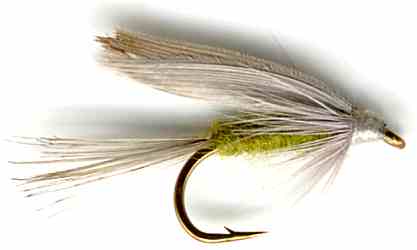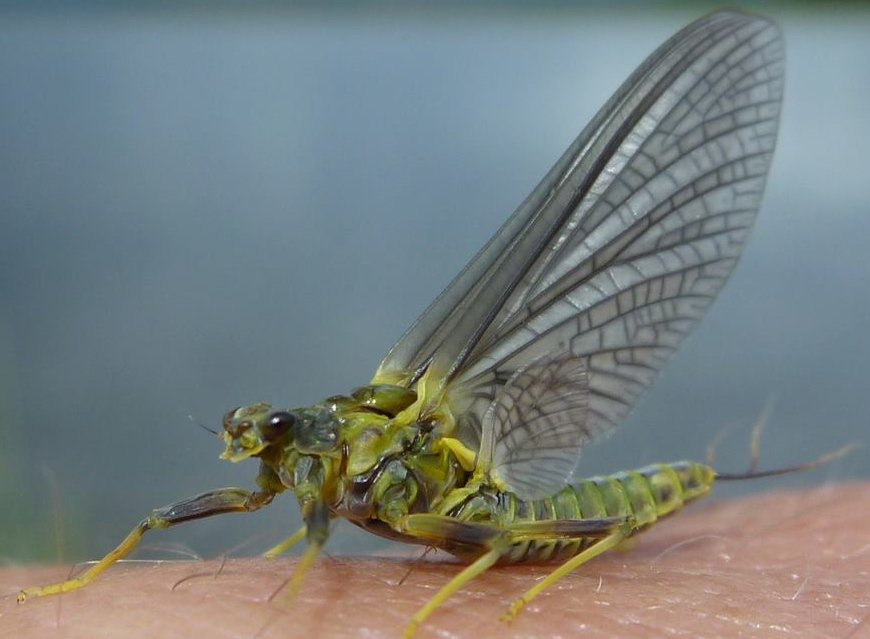The Blue Winged Olive Wet Fly
There are many species blue-winged olive mayflies. Hatches begin as early as late September and continue until April, with the best activity in February and early March

WET FLY PATTERNS. Hook size 12 14 - $US each
Those fly fishermen that only pick up their rod in the late spring and summer months really miss some fine fishing. The scientific name is genus Baetis (pronounce beet-us)and Diphetor but the are more commonly known as BWOs, blue wing or tiny olives. Hatches normally start just after lunch. I have had the best hatches on days when it is drizzling. Search out back-eddies on the river. This is where I normally find blue-winged olive circle endlessly around and around. I think they like the air currents and this is where you will find the trout ready to suck them down. This fly also works well in slow run stretches of water. Use your eyes and hunt the swarms. The Pheasant Tail Nymph and Gold Ribbed Hare's Ear nymphs are ideal imitations for the blue-winged olive's early stages. Drift them near the bottom any day between September to April that is if your part of the world is not covered in ice.

Use a BWO wet fly as a caddis pupa imitation
At times trout appear to be feeding on the surface, but refuse to take a dry fly no matter how realistic the fly pattern or how perfect your presentation. The remedy for this situation is to fish a wet fly just below the surface. When there is no surface feeding apparent then it is defiantly a wet fly situation.
If you are on the water when a caddis hatch in full swing try a sing a Blue Winged Olive wet fly (BWO) to represent a caddis pupa rising to the surface to hatch. The soft fibers of the olive body pulsate and appear to swim in the water, movement that makes this wet fly look alive. I have found that picking out some additional fibers with the hook of another fly to make it look scruffy really helps.
This movement is a very important characteristic of a successful fly. Remember the fly has to look good to the trout not the angler, who may prefer the appearance of a neatly tied artificial to a more untidy looking example.
The caddis pupa first becomes available to the fish after the pupa has crawled out of its larval casing but is not quite ready to hatch. It will crawl around on the bottom waiting for the right hatching conditions.
When the time comes the pupa swims towards the surface and becomes easy prey. They are readily eaten by lurking hungry trout. More caddis are devoured in their pupa state than when hatching on the surface. So it is logical that the angler will catch more fish if he uses a subsurface caddis pupa imitation than a surface dry. (Saying that I still love fishing a dry)
The caddis pupa has longish legs which it uses for swimming as it moves towards the surface. This is imitated by the movement of the body fibers. Many caddis pupa have olive bodies and over their back they have under developed wings. All these features are represented in the BWO wet fly.
I often fish a BWO wet on a dropper tied under a floating Elk Hair Caddis or Goddard's Caddis dry fly. Most of my takes occur on the subsurface Blue Winged Olive wet fly. Give this set up a try and see what results you get.
Fly fishing tactics in the rain
I like to fish wet flies in the rain. If you are one of those fine weather fishermen you are missing a lot of sport. On sunny days the fish swim near the bottom of the river, lake or stream for a number of reasons. They do not have eye lids and the sun can damage the eyes. More importantly the warmer the water becomes the less oxygen it can hold. Fish find warm water uncomfortable. The colder the water temperature the more oxygen the water can hold. When it rains the disturbance caused on the water surface increases the oxygen content of the upper levels of water because when the water droplets force their way through the water surface air gets trapped behind it. If it is raining it normally means the sky is overcast and therefore the temperature of the water decreases. This cooling effect is also helped by the rain drops which are normally cold and help cool the upper water levels of the lake or river to a more pleasant fish friendly environment.
They feel safer as choppy water makes them invisible to birds of prey. Heavy rain will knock airborne and surface insects down and into the water. More fish than normal rise from their bottom feeding location to the surface to feed from this bounty of drowned insects. Heavy rain also washes terrestrial insects like ants, beetles and Hoppers into the water from the land, overhanging trees and shrubs. Summer storms are primetime for subsurface fishing with a wet fly. Further advantages of fishing in heavy rain is that perfect fly presentation is less important. A fish who is stimulated by the abundance of drowned insect food, whilst on the look out for predators, will not have time to consider such things.
When the all the fair-weather fishermen are hiding under trees, in fishing huts or in their cars to keep dry, you will reap the rewards of some exciting fishing if you stay out in the rain. Just cast out your fly and let the rain drown it, just like what is happening to the real insects. Do not add any floatant. It is best to cast frequently as you will cover more water and I have found that the fly is normally taken just after it has broken the water surface. Fishing in heavy rain is an ideal time to try out new patterns . Trout have learned to expect a variety of different foods, not normally available to them,


Fly Fishing books

